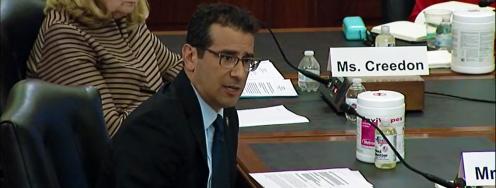B61 Modernization: Cost Overruns and Added Military Capability
On the radar: Golden nuke hits troubling milestones; the Uselessness of tactical U.S. nukes; More to accomplish in Iran nuclear negotiations; NNSA pushes back on budget accountability; Radioactive waste cleanup tops $30 billion; Demanding details on a nuclear dump; and MOX a nuclear bridge to nowhere.
May 19, 2014 | Edited by Lauren Mladenka
Achieving milestones - “After three years of intense work, Sandia National Laboratories has reached a key milestone in its efforts to modernize the B61 nuclear bomb – one of the oldest and most versatile weapons in the nation’s nuclear arsenal,” writes Kevin Robinson-Avila in the Albuquerque Journal. “The bomb modernization program, which aims to extend the B61′s life another 20 years, is one of the biggest endeavors undertaken at Sandia since before the Cold War ended. The government is spending upwards of $8 billion on the project, part of a broad national effort to modernize most of the nation’s nuclear military complex during the next decade.”
--“Critics question the cost of the overall modernization plan, which has skyrocketed from an estimated $4 billion in 2010 to at least $8 billion today. They also fear the new tail kit guidance system, along with other modifications, add new capabilities to the weapon, potentially undermining the government’s declared policy of simply extending the life of nuclear arms without creating new ones.” Read the full article here. http://bit.ly/1nYMWZC
Tweet - @globalzero: #ExposeNukes Excited about @GameOfThrones tonight? Well, consider this: ow.ly/i/5ARKr
Uselessness - “Less than a week after Russia carried out a nuclear strike exercise, the United States has begun its own annual nuclear strike exercise,” writes Hans Kristensen in the Federation of American Scientists Strategic Security Blog. “The exercises conducted by the world’s two largest nuclear-armed states come in the midst of the Ukraine crisis, as NATO and Russia appear to slide back down into a tit-for-tat posturing not seen since the Cold War. Military posturing in Russia and NATO threaten to worsen the crisis and return Europe to an ‘us-and-them’ adversarial relationship. One good thing: the crisis so far has demonstrated the uselessness of the U.S. tactical nuclear weapons deployed in Europe.”
--“[One] can argue with some validity that spending hundreds of millions of dollars on maintaining U.S. non-strategic nuclear weapons in Europe after the end of the Cold War has done very little for NATO security, except wasting resources on a nuclear capability that is useless rather than spending the money on conventional capabilities that can be used. It is about fake versus real assurances. The deployment of U.S. nuclear weapons in Europe seems to be for academic and doctrinal discourses rather than for real security. In the real world they don’t seem to matter much and seem downright useless for the kinds of security challenges facing NATO countries today. But try telling that to current and former officials who have been spending the past five years lobbying and educating Eastern NATO governments on why the weapons should stay.” Full article here. http://bit.ly/1p66AAb
Ups and downs - “Iran and six world powers made little progress this week in talks on ending their dispute over Tehran's nuclear program, U.S. and Iranian officials said on Friday, raising doubts over the prospects for a breakthrough by a July 20 deadline,” write Justyna Pawlak and Fredrik Dahl in Reuters. “‘We believe there needs to be some additional realism,’ a senior U.S. official said on condition of anonymity, declining to provide details on what issues had caused the most difficulty. ‘Time is not unlimited here… In any negotiation there are good days and bad days, there are ups and downs, this has been a moment of great difficulty but one that was not entirely unexpected… We are just at the beginning of the drafting process and we have a significant way to go.’" Full story here. http://reut.rs/R04HsM
How it played - “The difficult path to a nuclear deal with Iran” Editorial from The Washington Post. http://wapo.st/1hXM7sz
Lax accountability - “The U.S. nuclear weapons agency is rejecting a finding by auditors that it should know how much money it could save by pursuing certain efficiencies,” reports Rachel Oswald for Global Security Newswire. “The National Nuclear Security Administration was required under the fiscal 2012 defense authorization law to issue a report to Capitol Hill examining areas within its enterprise where it could operate more efficiently and save money by doing so. A Thursday report by the Government Accountability Office found that while the agency's assessment -- eventually delivered to lawmakers in November 2013 -- did highlight seven ‘opportunities for efficiency,’ it failed to provide estimates on the cost savings that could be realized with those projects.”
--“The semiautonomous Energy Department branch, in its comments to auditors, disputed the finding that it was required under the 2012 legislation to ‘casually and quantitatively link its cost efficiency initiatives to specific cost savings…’ The nuclear agency's spending decisions are currently under the microscope in light of a broader congressional atmosphere of budget-tightening and, more specifically, because NNSA officials in recent years have overseen a number of projects that have far exceeded initial cost projections.” Read the full article here. http://bit.ly/Sak5UB
Tweet - @globalzero: #Godzilla: an uncontrollable, destructive & terrifying monster created by man. Sound familiar? owl.li/x0LRT
Pricey cleanup - “The cleanup of the nation's largest collection of radioactive waste left over from the production of nuclear weapons was supposed to be nearing an end by now,” writes Nicholas Geranios the Greenwich Time. “Twenty five years ago, a landmark agreement was signed to deal with the millions of gallons of waste at the Hanford Nuclear Reservation in southeastern Washington. More than $30 billion has already been spent under the so-called Tri-Party Agreement signed by the U.S. Department of Energy, the U.S. Environmental Protection Agency and the Washington state Department of Ecology. If everything had gone according to plan, the work would be only about five years away from completion. But Hanford officials are still decades and tens of billions of dollars away from finishing the cleanup of the radioactive mess.”
--A Washington state Department of Ecology official “points to a combination of the scientific complexity of the work and the limits of the federal budget. The cleanup budget is currently about $2 billion per year, which is not enough to meet agreement deadlines… It needs to be $3 billion to $3.5 billion a year to stay on schedule.” The official “predicted that cleaning up Hanford would take 40 to 50 more years, with the most difficult work — emptying 56 million gallons of waste from the underground tanks — still left.” Get the full story here. http://bit.ly/1o6ZCLp
Demanding details - “New Mexico wants to end federal breaches of reporting rules for dangerous substances at a nuclear dump near Carlsbad,” Global Security Newswire reports. “The state's environmental agency this week formally ordered the Energy Department to explain how it will fall back in line with rules requiring weekly declarations on levels of methane, hydrogen and other hazardous substances at the Waste Isolation Pilot Plant… Federal officials began running afoul of the requirements after an escape of radioactive contaminants forced workers to vacate underground portions of the site in February.” Full article here. http://bit.ly/1jvq1TQ
Exercising diplomacy - “China has used diplomatic channels to warn North Korea against conducting a fourth nuclear test,” after North Korea “renewed its threat of ‘counter-measures’ against perceived U.S. hostility,” reports Megha Rajagopalan for Reuters. “The United States has said it hopes China will use its influence to coax the North to abandon its banned nuclear weapons program. In recent public statements, Chinese foreign ministry officials have repeatedly called on all parties to ‘exercise restraint’ on the Korean peninsula, without pointing the finger at North Korea alone.” Full article here. http://reut.rs/1sL7lio
Bridge to nowhere - With their “lobbying on behalf of French conglomerate Areva to produce mixed-oxide fuel (MOX) from spent nuclear materials at the Savannah River Site (SRS),” Sen. Lindsey Graham and Gov. Nikki Haley are overlooking the facts that “Areva’s MOX process, designed to recycle spent fuel from commercial nuclear reactors, cannot recover alloyed weapons-grade (non-proliferation) plutonium without extensive redesign and cost overruns” and “the market for MOX is in decline since the Fukushima disaster. Germany is dismantling its entire commercial nuclear program and is negotiating to send nuclear waste to SRS,” among other problems. “The SRS MOX facility is a multibillion dollar bridge to nowhere and South Carolina is ill-suited to serve as an international repository for high-level nuclear waste.” Read the full piece by Victor Volskay, Jr. in The Greenville Times here. http://grnol.co/1hXFuX7
PrepCom - “The U.N. just concluded the Nuclear Non-Proliferation Treaty (NPT) Preparatory Committee with representatives from the 189 signatory nations and of civil society,” write Jody Williams and Robert Dodge in The Hill. “The meeting was in preparation for next year's NPT conference and to discuss the current status of fulfilling the obligations under the treaty and in particular, the mandate of the nuclear weapons states for global disarmament. The outcome was a continued foot dragging by the nuclear states motivating a demand for meaningful steps and progress toward disarmament by the other 184 nations in view of current international events.” Read the full article for perspective and political context on the NPT PrepCom. http://bit.ly/1tafHSZ
Tweet - @WinWithoutWar: Tell #Obama, thanks for saying #LetDiplomacyWork w/ #Iran! via @Livableworld http://livableworld.org/iran2014/
Quick-hits:
--“Hawaii missile launch tests shield readiness” from AP. http://bit.ly/1nXOAIz
--“Next Iran nuclear talks due on June 16-20: IRNA” by Michelle Moghtader and Fredrik Dahl in Reuters. http://reut.rs/Sax6O3
Events:
--“The Role of Tactical Nuclear Weapons in Responding to the Crisis in Crimea.” Discussion with Peter Doran and Kingston Reif. May 19 from 6:00 to 8:00 at the Center for Strategic and International Studies, 1616 Rhode Island Ave., NW. RSVP here. http://bit.ly/1iUUxA6
--“Nonproliferation Challenges to International Security.” Discussion with Thomas Countryman. May 19 from 7:00 to 8:00 at the World Affairs Council, 312 Sutter St., Suite 200, San Francisco. RSVP here. http://bit.ly/1hXGYRt
--“Nuclear Weapons: How Safe is Safe?” Discussion with author Eric Schlosser. May 22 from 8:30-9:30am at the Rayburn House Office Building, Room 2212. RSVP to rsvp@ploughshares.org.
--“The Korean Peninsula Issues and U.S. National Security.” Discussion with Wallace Gregson, Gen. Seung Jo Jung, Joseph Bosco, David Maxwell, and Larry Niksch. May 23 from 1:15-4:30 at 345 Cannon House Office Building. RSVP here. http://bit.ly/1lBkqXQ
--“The United States and Global Missile Defense.” Discussion with 20 policy experts. May 28 at 8:30am at the Atlantic Council, 1030 15th St. NW, 12th floor, West Tower. RSVP here. http://bit.ly/1lFlA5Z
Dessert:
Throwback calculators - In 1950, with the Cold War in full swing, the public could purchase a Radiation Dosage Calculator designed by William Orr and commissioned by the Connecticut State Office of Civil Defense for the going price of $1. View this and other Cold War calculators in Retronaut. http://bit.ly/SGLKxb



